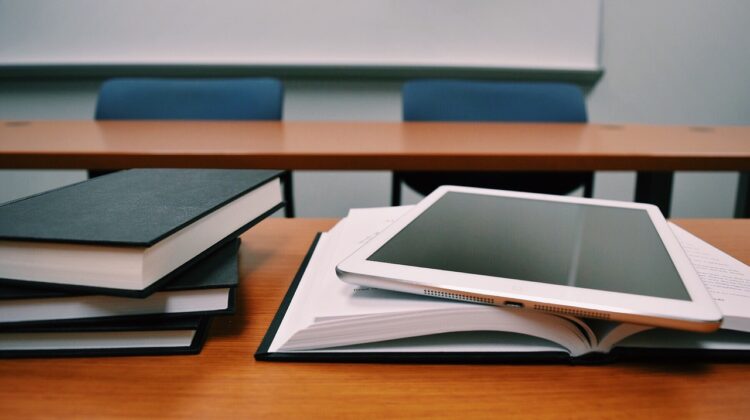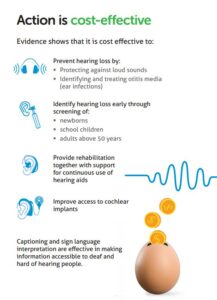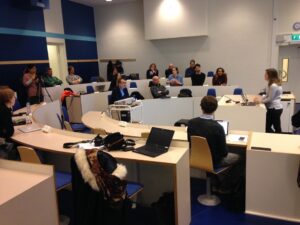
As many students are enjoying their midterm break, it’s time to take a seat on the school bench for others. A group of European researchers, experts and industry partners is gathering to share insight on children’s auditory rehabilitation for three days as part of iCARE’s third winter school in Linköping, Sweden. The iCARE (improving Children’s Auditory Rehabilitation) project is supported by the European Union and aims to find synergies between different research disciplines that ultimately improves the lives of children with hearing impairment, their parents and other people around them.
The winter school includes a solid program on topics such as cognitive training for language acquisition, mutual gaze, spatial hearing abilities and real-time auralisation systems.

The timing is perfect as tomorrow, 3 March is WHO’s World Hearing Day, which aims to raise awareness and promote ear and hearing care. The theme for World Hearing Day 2017; “Action for hearing loss: make a sound investment”; draws attention to the economic impact of hearing loss. Interventions to address hearing loss are available and are cost-effective. Prevention, screening, rehabilitation are all important actions.
We were curious to find out a bit more about the research, what drives the researchers, and their take on how the building industry can support their mission. Here’s what a few of the presenters and participants answered.
Katharina Vogt, PhD Student, Radboud University Nijmegen, Donders Institute for Brain, Cognition and Behaviour, Dept. Biophysics, Netherlands
Q: What will you be presenting at iCARE winter school?
A: At the 3. iCare winter school I will present data collected from children and adolescents, who suffer from hearing loss due to ear deformities and have been fitted with an implant system. The aim of the study was to evaluate the patients’ spatial hearing abilities with their device on in comparison to without. Do these devices provide access to additional auditory information to improve sound localisation performance?
Q: How do you hope that your research and knowledge will improve the world for those with hearing impairment?
A: I am aware of the fact that I am just one piece of a big puzzle. However, I hope to make a small impact at least. Medical treatment of children with a unilateral hearing loss or a single sided deafness still varies from clinic to clinic and from country to country. Treatment is not always evidence-based and when it comes to choosing an implant the etiology, medical history, local rules, available funding and preference of the patient still play a big role.
My goal is to help formulate clearer treatment standards for clinicians!
Q: What can schools do to improve inclusion in classrooms?
A: One of the main improvement areas I noticed when talking to children with a hearing loss, their parents and medical professionals, is education of teachers. I have heard sad stories where teachers were either overwhelmed with a hearing-impaired child or completely ignored that fact!
Education, awareness and understanding are the most important keys for inclusion. Secondly, good acoustical treatment of classrooms is necessary to help a child with a hearing impairment. Additionally, it makes listening and communicating easier for teachers and pupils with no hearing loss as well.
Q: What can the building industry keep in mind when it comes to children with hearing impairment?
A: In general, good acoustic design ensures the efficient distribution of desirable sounds as well as the exclusion of undesirable sounds. And everyone knows that this is important for concert halls, theatres and schools for hard-of-hearing. However, more time is being spent at home, in offices, regular schools and so on. Sadly, most of these places have an insufficient acoustic environment. Therefore, good acoustics should play a role during the design process of a building, since changes at a later point are expensive.
Not only will well-designed acoustic buildings help the inclusion process of children with a hearing impairment, it will help everyone to live and work in a healthier ‘hearing’ environment.
Q: How do you see the future regarding hearing and children’s auditory rehabilitation?
A: I hope to see more awareness and understanding for children with a hearing impairment. However, in the last few decades more and more effort has been put into strengthening inclusion of children with a disability in mainstream schools. A shift in perception is taking place, where it is accepted that not only the hearing loss itself is holding a child back, but an insufficient environment as well! It is on us to create such an environment that every child can reach its full potential whether it is hearing impaired or not. New technical developments as well as research support and expedite this process. However, funding is essential and cannot be ignored in order to see this development to continue. I am very hopeful for the future because especially for children it is important to belong and not to be excluded.
Björn Lyxell, Professor, Linköping University, Sweden
Q: How do you hope that your research and knowledge will improve the world for those with hearing impairment?
A: Rehab/habilitation, intervention, more precise hearing aids/CIs, a better understanding of the sound environment.
Q: What can schools do to improve inclusion in classrooms?
A: Much more, particularly for children with CI (cochlear implants) integrated into hearing schools.
Q: What can the building industry keep in mind when it comes to children with hearing impairment?
A: The connection between cognition and listening effort in noisy environments. (EDITOR’S NOTE: Useful presentation on this topic here.)
Q: How do you see the future regarding hearing and children’s auditory rehabilitation?
A: It will become more important as our knowledge about cognitive intervention increases.
Florian Pausch, Research Assistant, Institute of Technical Acoustics, Teaching and Research Area Medical Acoustics, RWTH Aachen University, Germany
Q: What will you be presenting at iCARE winter school?
A: I will talk about the application of a real-time auralisation system extended for people with hearing loss including simulated hearing aid signals and room acoustics. In the current study, the speech perception of children bilaterally fitted with hearing aids is compared to the results of age-matched normal-hearing children. Speech reception thresholds were measured adaptively in a target-distractor paradigm with manipulations of the distractor’s location, distractor’s voice or both under two room acoustic conditions. Results reveal a main effect of distractor location, distractor voice and reverberation time on speech reception thresholds.
Q: How do you hope that your research and knowledge will improve the world for those with hearing impairment?
A: The developed real-time auralisation system is a step towards the accessibility of virtual acoustic environments for hearing aid users. Despite a usage in research as non-invasive and fully controllable measurement instrument, the system can be used for effective auditory training in realistic real-life situations. In future clinical practice, an optimisation of the hearing aid fitting process is conceivable to potentially overcome the gap between hearing aid performance under laboratory conditions and the perceived performance of the user in real-life situations.
Q: What lead you to research this topic or field of knowledge?
A: This field of research is highly interdisciplinary and demands knowledge in various domains such as acoustics, signal processing, audiology and statistics. The fusion and application of these areas to investigate the needs of people with hearing loss is not only challenging but hopefully leads to expedient insights enabling an early and effective intervention to overcome issues related to hearing loss.
Q: What can schools do to improve inclusion in classrooms?
 A: Several scientific studies already confirmed the need for good room acoustics in classrooms to enable an easy speech perception especially for children with hearing loss. Thus, it is the responsibility of school principals to collaborate with room acoustic companies to enable good room acoustics through structural measures. Even if these conditions are met, teachers have to complete courses to improve communication strategies when teaching children with hearing loss.
A: Several scientific studies already confirmed the need for good room acoustics in classrooms to enable an easy speech perception especially for children with hearing loss. Thus, it is the responsibility of school principals to collaborate with room acoustic companies to enable good room acoustics through structural measures. Even if these conditions are met, teachers have to complete courses to improve communication strategies when teaching children with hearing loss.
Q: What can the building industry keep in mind when it comes to children with hearing impairment?
A: To minimise the background noise level in classrooms more focus has to be put on the structural design of buildings. Low-noise ventilation systems and walls with a high sound reduction index to prevent impact sounds from neighbouring classrooms and to reduce outdoor noise should be more strictly defined in building requirements by the government.
Q: How do you see the future regarding hearing and children’s auditory rehabilitation?
A: Virtual acoustic environments in combination with visual virtual reality show an immense potential for auditory rehabilitation designed as a multimodal game. The combination of these technologies may be very attractive especially for children and can thus be used as an effective tool to train hearing abilities in everyday life.
Astrid van Wieringen, Dept. of Neurosciences, Research Group Experimental Oto-rhino-laryngology, KU Leuven, Belgium
Q: How do you hope that your research and knowledge will improve the world for those with hearing impairment?
A: I hope that my research will lead to evidence-based decisions in audiological rehabilitation and that it can make a difference for those who struggle with communicating in daily life.
Q: What lead you to research this topic or field of knowledge?
A: A profound interest in understanding how deficits in sensory processing affect linguistic and cognitive development in children.
Q: What can schools do to improve inclusion in classrooms?
Q: Make teachers and pupils more aware of what it means to be hearing impaired.
Q: What can the building industry keep in mind when it comes to children with hearing impairment?
A: Many spaces are built with a limited budget (concrete floors, concrete wall, no ceiling …). With some relatively small changes, reflections and reverberation should be able to be controlled.
Q: How do you see the future regarding hearing and children’s auditory rehabilitation?
A: I see a quite bright future. Compared to the past, children perform much better due to intervention at an early age. However, performance can vary significantly from child to child and it is important to target the audiological rehabilitation more to the needs of the individual. It is also important to provide better audiological rehabilitation to children with mild and moderate hearing loss. In general, they receive less care than children with profound bilateral hearing impairment.
Michaela Socher, PhD student, Linköping University, Sweden
Q: What will you be presenting at iCARE winter school?
A: I will present a study about cognitive training. The training aims to train the cognitive skills needed for language acquisition. We have tested the program with 16 hearing children and I am going to present the results of the pre- and post-test.
Q: How do you hope that your research and knowledge will improve the world for those with hearing impairment?
A: A relatively high proportion of children with a cochlear implant show a delay in their language and cognitive development. I hope to learn more about the connection between different cognitive and language skills and thus find ways to train children with language problems.
Q: What lead you to research this topic or field of knowledge?
A: I’ve studied cognitive science and was always interested in language acquisition. Furthermore, I’ve written both my Bachelor and my Master Thesis about the influence of background noise on cognition, this was when I became interested in the connection between language, cognition and hearing.
Q: What can schools do to improve inclusion in classrooms?
A: Consider ways to improve the acoustics, using modern technology to be able to offer individual training und using individual teaching material.
Q: How do you see the future regarding hearing and children’s auditory rehabilitation?
A: My hope for the future is that we gain more knowledge about the connection between language, hearing and cognition. This knowledge could be used to design individual training programs and optimal learning and working environments.
Prof. Dr G. Lichtert, Research Group Experimental Oto-rhino-laryngology, KU Leuven, Belgium
Q: What will you be presenting at iCARE winter school?
A: Observing and classifying mutual gaze patterns between parent and child.
Q: How do you hope that your research and knowledge will improve the world for those with hearing impairment?
A: Mutual gaze reflects shared attention which is necessary for effective supportive communication. Deaf children (deaf means in this context all degrees of hearing loss) need more visual cues (speechreading, gestures, signs) for language learning to compensate for missing information due to shortcomings in hearing technology and acoustic environment. It helps adults to ensure on-topic and responsive interaction with their child. It is also a good indicator to measure the effectiveness of the auditory rehabilitation in real life conversations.
Q: What lead you to research this topic or field of knowledge?
A: Forty years of experience and research in deaf education as well as parental support to make them effective communicators with their own deaf child.
There is no effective parenting without effective communication with the child. For 95% of deaf children with hearing parents, inclusion has to start in their own family.
Q: What can schools do to improve inclusion in classrooms?
A: Offering enough training possibilities and additional support for teachers in the mainstream to understand the impact of a hearing loss on learning (cognitive and socio-emotional), and to provide them with knowledge of effective learning strategies for deaf children as well as skills to create optimal listening and visual learning environments. Offering classrooms with optimal acoustic and visual conditions for optimal speech transmission.
Q: What can the building industry keep in mind when it comes to children with hearing impairment?
A: Beginning with asking architects not only to use their eyes but also their ears. Be aware to guarantee environments (houses were families has to live with a deaf child, day care centres, schools, places for leisure time…) with optimal speech transmission qualities.
More about iCARE

The goals of iCARE are to:
- provide training to create a new generation of researchers capable of exploiting the synergies between different disciplines to optimise spoken communication in children with hearing impairment.
- combine research across disciplines to develop novel methods, training skills and procedures for improving auditory rehabilitation and use the generated knowledge, products and skills to empower children and adolescents with hearing disabilities as well as their parents, caregivers, educators, speech therapists, medical professionals and other involved persons.
Without appropriate handling, a child with hearing impairment can lag behind in learning and social-emotional development, with consequences for his/her social interaction and future employment. That is why it is very important to explore and spread knowledge on how to prevent this to happen. Moreover, the EU promotes the active inclusion and full participation of disabled people in society, in line with the EU human rights approach to disability issues.
Here you can find information on the iCARE project Early Stage and Experienced Researchers.
https://icareitn.eu/2.4.2-fellows
https://icareitn.eu/fellows/esr (Early Stage Researchers)
https://icareitn.eu/fellows/experienced-researchers (Experienced Researchers)


